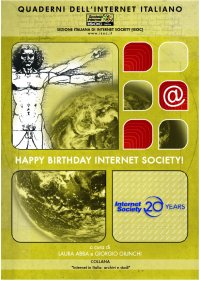- The Internet
is the generic service par excellence: neutral interconnection of automatic
information.
- At a global
level obviously: the Internet has no boundaries, by definition.
- An elementary
corollary of the history, and historiography of the net, is that the "Italian
contribution to the evolution of the Internet" is a coin with two
faces: local implementation of structural network nodes, and their respective
coordination at international level.
- In practice:
in the 1980s, all over the world, at different rhythms and speeds depending
on the country, the avant-garde university and research communities adopted,
imported, distributed locally, and tested various prototypes of networks
to provide fundamental services: distribution of calculations, transfer
of files and email.
- At the
time the following were all competing to become standard:
- some proprietary
networks [foremost DECNET developed by Digital and SNA by IBM];
- an institutional
network politically tied to European institutions [X25 OSI];
- and a
more flexible network, developed in the US but open and neutral, non-proprietary
by design as it grew from an academic military matrix [ARPANET]: the protocol
stack TCP/IP.
- From the
beginning of the 90s network watchers all noticed a simple truth: "everyone
wants TCP/IP".
- The aspect
we would like to document in this section is the process by which Italy
was one of the first transatlantic countries to embrace the international
hegemony of the Internet as we know it now, the neutral version that went
on to become dominant.
- Classic
cases regarding the Italian contribution to the evolution of the Internet
were a timely interface between CNUCE and ARPANET and soon after the accreditation
that IANA conferred on 23 December 1987 [one of the first European delegations],
again on CNR-CNUCE, for the management of the ccTLD .it.
- The sequence
of events begins with the original Italian growth of these networks and
documents national developments and international co-ordination of their
structural nodes:
- Research
Networks;
- Registries
of Domain Names;
- Regulatory
and Protocols Offices;
- Operators'
Internet Exchanges.
- The section
ends with the progressive transfer of know how from the academic and research
networks to civil use and finally business: at the dawn of mass-use Internet,
when the Internet "swamps the market" and starts to affect the
way of life of common people.
|
![]()
![]()
![]()
